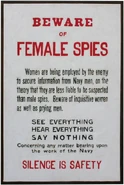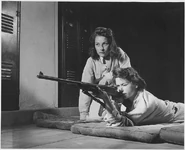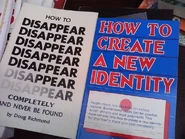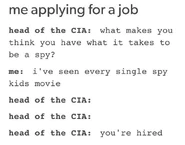Spy Fiction is a genre that involves espionage, the covert gathering of information to be delivered to a third party. Mostly, the works in spy fiction focus on agents employed by the government to retrieve stolen information and objects, discover double-crossers, or end world-ending machines from nefarious villains.
The blueprint for most fictional work involving spies comes from Ian Fleming's James Bond series, which glamorized the life of spies; in fiction, these secret agents tend to be highly trained in a variety of stunts and visit exotic and luxurious locales while being hindered by incredibly sophisticated technology and seductive characters. However, the reality of spies is entirely different from the portrayal in fiction, with their activities being more mundane. There is a spectrum in Spy Fiction from being completely fantastical and even campy to dark and gritty. The commonalities between both is the emphasis on the agent being able to escape dangerous situations, the use of action and disguise, and an organization existing to give orders to the agent.
Criticisms[]
Issues with Diversity and Representation[]
Spy fiction tends to be written by white men. Because of this, female characters are often subject to sexist treatment, or are placed in non-consensual sexual situations. Characters of color, when they appear at all, are subject to slurs and stereotyping.
Violence[]
Extreme violence such as interrogation torture and gun violence is common in spy fiction.
History[]
The oldest spy story can be found in the Book of Joshua in the Hebrew Bible. Spy fiction is generally associated with the World War Two and Cold War eras, but spying and secret agents have existed during many wars as well as in times of peace. After the Cold War, the discovery of espionage training programs led to the appearance of spy schools in fiction. Spy fiction in the 1960s could be extremely serious, reflecting the fears of the public during the Cold War era, or it could be humorous and lighthearted, in an attempt to push back against these fears. Humorous spy fiction often parodies more serious spy fiction with references to characters and titles which existed previously. In the late 20th century, spy fiction began to be marked to children. Children's spy fiction is often more easy-going and focuses a lot less on the violence and/or sexual content common in spy fiction created for adults.
Typical Character Types[]
- The Handler - Can be a mentor figure or an "mentor" figure the spy is trying to escape from
- The Spy (Also called Agent or Secret Agent) - Always the best, unless it is a comedy. Then the spy is clumsy and clueless.
- The Femme Fatale
- The Gadget Expert - Usually much younger than The Spy
- The Love Interest, often:
- A Femme Fatale
- A Civilian
- Another Spy
- An Enemy Spy
- The Enemy Spy - A rival with similar or better skills than The Spy
- The Civilian/s - Innocent bystanders and sometimes providers of helpful information. Most likely to be seen shouting about their produce stand being knocked over after a chase.
Additionally, "The Spy" often has a "backup team", often containing a getaway driver, a tech guy, and a sniper, e.g. Benji and Luther acting as Ethan Hunt's backup team in the Mission: Impossible films.
Visuals[]
- Concealed carry guns and various forms of clandestine weaponry
- Poisons and chemicals
- Gadgets
- Sheets of plans/maps, including coded messages
- Sports cars/vintage cars, planes (especially private jets) and yachts
- Fire and explosions
- A signature drink, such as James Bond's martini
- Abandoned and condemned buildings
- English manor houses and estates, castles and secret passageways
- Balls/events
Activities[]
Spies have a large variety of skills which they can be called upon to use during missions. Many of these are associated with the lifestyles and aesthetic of the wealthy.
Sports[]
- Tennis
- Golf
- Skiing
- Swimming
- Archery
- Hunting/Shooting
- Martial Arts - Karate, Taekwondo, Kung Fu, Judo, Aikido, Jujutsu
- Boxing
- Sailing
- Gymnastics
Games[]
- Chess
- Cards: Baccarat, Blackjack, Poker
Skills[]
- Ballroom dance
- Chemistry
- Coding
- Cooking
- Disguise
- First Aid
- Knowledge of foreign languages and codes
- Mixing drinks
- Seduction
- Wilderness survival
Fashion[]
Much of the clothing associated with Spy Fiction is inspired by spy movies from the 1960s, when characters wore black turtlenecks and tan trench coats. A trench coat and fedora hat is often used to symbolize a spy's disguise, although this outfit is so out of fashion in today's world that it would be a completely ineffective one.
Disguises[]
Spies often desire to blend in with their surroundings as opposed to standing out. Most spy stories involve "The Spy" infiltrating a fancy event (e.g. ball) and therefore most spies will have a specific disguise for events like this.
Outfits[]
- Tuxedos (white tie/black tie)
- Long dramatic ballgowns
- Heels/dress shoes
- Lots of jewellery
In the Field[]
Spies are usually required to do "field work" which can hugely vary location-wise, from busy city centres, to arctic tundras, to hot desert valleys. Garments that have mission capability/durability etc are used by agents and operatives. Colors, usually militaresque like black, gray, tan, brown, navy and green are typically worn, as well as camouflage (the latter not as a uniform but for concealment/deception only). Layers are worn to regulate body temperature/ease of disguise/interface of garments, and footwear that are easy to run, jump, and climb in. Blouson jackets are typically worn, centralizing important EDC items to the wearer and allowing ease of swift movement.
City Centres[]
- Jeans/cargo trousers
- T-shirts
- Monochromatic black outfits
- Long jackets/trenchcoats
Cold Location[]
- White/grey camouflage
- Thick winter jackets
- Skiing attire
- Snow boots
Hot Location[]
- Green/tan camouflage
- Thin/Fishnet vest tops/t-shirts
- Shorts/cargo trousers
- Trainers/sneakers
Accessories[]
- Concealed thigh holsters (often holding a gun or a knife)
- Briefcases/duffel bags
- Umbrellas
- Goggles/glasses (often with a dual purpose)
- Hats (thick winter ones or small summer caps)
- Gadgets with dual purposes (pen with a camera, etc)
- Mission gear such as belt kit, climbing harnesses, gloves for gripping walls/protection etc, grappling hooks etc
- Ninja gear, or similar clothing for night ops
- Tactical/bullet proof vests (often concealed)
- Tacticlip (often worn by women)
Stores[]
- Bohomme - replicas of the map scarves wore by spies during World War Two
- Burberry
- Chanel
- Fishnet Shirts
- GENA shoes
- Kingsman
- Louboutin
- Magnoli Clothiers
- Rent the Runway
- Swinging Chicks Shop - replicas of Gabby's outfits from The Man From U.N.C.L.E.
Media[]
Music[]
Music in spy fiction covers nearly every musical genre (e.g. the James Bond films will have dramatic pop and classical music, whereas Spies in Disguise will have lighthearted and happy pop music). If the spy fiction is set during a historical time period, popular music from the day is used.
Albums[]
- Skyfall by Thomas Newman
- Marvel's Agent Carter by Christopher Lennertz
Songs[]
- A Man for All Seasons by Robbie Williams
- I Wish I Was James Bond by Scouting for Girls
- Skyfall by Adele
- No Time To Die by Billie Eilish
- Never Say Never Again by Lani Hall
- The Living Daylights by A Ha
- Licence to Kill by Gladys Knight
- Theme from Mission: Impossible by Lalo Schifrin
- Secret Agent Man by Bruce Willis
Musicals[]
- Spies are forever by Tin Can Bros
Movies[]
- Austin Powers movies
- James Bond movies
- Spy Kids movies
- Jason Bourne movies
- Mission: Impossible movies
- Triple B movie series by Andy Sidaris
- xXx franchise
- The Spy Who Came in From the Cold (1965)
- The Ipcress File (1965)
- The Fourth Protocol (1987)
- Black Eagle (1988)
- If looks could kill/Teen Agent (1991)
- The Berlin Conspiracy (1992)
- Miss Congeniality (2000) and Miss Congeniality 2: Armed & Fabulous (2005)
- Johnny English (2003) and Johnny English Strikes Again (2018)
- D.E.B.S. (2004)
- Mr. And Mrs. Smith (2005)
- Stormbreaker (2006)
- Salt (2010)
- Cars 2 (2011)
- Argo (2012)
- This Means War (2012)
- Kingsman: The Secret Service (2014), Kingsman: The Golden Circle (2017) and The King's Man (2021)
- Spy (2015)
- The Man from U.N.C.L.E. (2015)
- Atomic Blonde (2017)
- A Call to Spy (2019)
- Red Sparrow (2018)
- The Spy Who Dumped Me (2018)
- Spies In Disguise (2019)
- Black Widow (2021)
- My Spy (2020)
- Carmen Sandiego
TV Shows[]
- The Man from U.N.C.L.E. (1964-1968)
- Get Smart (1965-1970)
- Tinker Tailor Soldier Spy (1965)
- Mission: Impossible (1966-1973) (1988-1990)
- Acapulco H.E.A.T. (1993)
- Chuck (2007-2012)
- Burn Notice (2007-2013)
- Archer (2009-)
- Nikita (2010-2013)
- Spy (2011-2012)
- Homeland (2011-2020)
- The Americans (2013)
- Agents of S.H.I.E.L.D. (2013-2020)
- TURN: Washington's Spies (2014-2017)
- Agent Carter (2015-2016)
- Quantico (2015-2018)
- Au service de la France (2015-2018)
- Alex Rider (2020-)
- Spy X Family (2022)
- Vagabond (2019)
Books[]
- Kim (1901) by Rudyard Kipling
- The Riddle of the Sands (1903) by Erskine Childers
- The Scarlet Pimpernel (1905) by Baroness Orczy
- The Secret Agent (1907) and Under Western Eyes (1911) by Joseph Conrad
- The Man Who Was Thursday (1908) by G. K. Chesterton
- The Thirty-nine Steps (1915) by John Buchan
- Ashenden: Or the British Agent (1928) by W. Somerset Maugham
- The Mystery of Tunnel 51 (1928) by Alexander Wilson
- Water on the Brain (1933) by Compton Mackenzie
- The Eunuch of Stamboul (1935) by Dennis Wheatley
- Noble House (1981) by James Clavell
- Red Sparrow (2013) by Jason Matthews
- Saint series by Leslie Charteris
- James Bond novels by Ian Fleming
- Gallagher Girls novels by Ally Carter
- Maids of Honor series by Jennifer McGowan
- Modesty Blaize series by Perer O'Donnell
- Spy School series by Stuart Gibbs
- The Agency series by Y.S. Lee
- Alex Rider series by Anthony Horowitz
- Ruby Redfort series by Lauren Child
- The Official CIA Manual of Trickery and Deception (declassified training manual used by the OSS, the precursor to the CIA)
Games[]
- Bio Menace
- Codenames
- Codename: ICEMAN
- David Wolf: Secret Agent
- East vs. West: Berlin 1948
- Flames of Freedom
- Hitman
- Mission: Impossible
- Operation Secret Storm
- Operation Stealth
- Secrets
- Sid Meier's Covert Action
- Sly Spy
- Spy Alley
- Strider
- Uncharted (1-4)
- Web of Spies
Notable Figures[]
1860s[]
- Harriet Tubman, a former enslaved woman, spied for the Union during the American Civil War. She was remarkably successful, considering she never learned how to read.
1940s[]
- Ian Fleming worked for the Naval Intelligence Division during the Second World War. In 1952 he published his first James Bond novel.
1950s[]
- John le Carré (real name, David Cornwell) worked for the British Security Service (MI5) and the Secret Intelligence Service (MI6) in the 1950s and 1960s. He published his first spy novel in 1965.
Resources[]
Playlists[]
Blogs[]
- Bond Lifestyle
- Iconic Alternatives - James Bond Fashion on a budget
Crafts[]
Youtube[]
- Ex-CIA Agent Rates 11 CIA Spy Scenes In Movies And TV
- Former CIA Operative Explains How Spies Use Disguises
- Former CIA Chief of Disguise Breaks Down 30 Spy Scenes From Film & TV
- Former CIA Chief of Disguise Breaks Down Cold War Spy Gadgets
- Former CIA Chief of Disguise Breaks Down Cold War Spy Cameras







